2/e
P
P T
©2007 by the McGrawHill Companies, Inc. All rights reserved.
4
Listening: A Silent Hero
©2007 by the McGrawHill Companies, Inc. All rights reserved.
McGrawHill/Irwin
Are You Listening?
Some professionals spend most of their working day listening to customers. © Keith Brofsky/Getty Images
3
Are You Listening?
•
Is Anybody Really Listening?
◦
involuntary physiological process of receiving sound waves through receptors in the ear that transmit them to the brain
Hearing
◦
active process of selecting, attending to, interpreting, and remembering sounds
• What’s the Difference Between Hearing
and Listening?
4
Listening
Are You Listening?
FIGURE 4.1 Profile of Business Communication Skills
5
Are You Listening?
FIGURE 4.2 Listening
6
Active Listening in Business
Active listening
◦
Listening to Learn
•
focusing on, interpreting, and remembering information
7
intrapersonal and interactive process in which we actively focus on, interpret, and respond verbally and nonverbally to messages
Active Listening in Business
• Practice Listening to Learn
8
Prepare yourself to listen actively Interpret message meaning & support memory Withhold judgment Outline message Take notes Mentally summarize information Ask questions Practice listening to challenging material
Active Listening in Business
Critical listening requires that you evaluate and analyze information in order to make a decision.
© Royalty-Free/CORBIS
9
Active Listening in Business
Critical Listening
◦ making assessments and decisions about what
Sensitive Listening
you hear
10
◦ supportive and nonjudgmental; it demonstrates empathy toward others when they share their thoughts and feelings
Active Listening in Business
• Practice Sensitive Listening
Take time to listen.
Empathize with the speaker.
Let the speaker vent.
Withhold judgment and criticism. Avoid downgrading.
Don’t offer advice or try to solve the problem.
Demonstrate supportive verbal & nonverbal feedback.
11
Active Listening in Business
Dialogue Listening
• Practice Listening in Business Groups
◦ used to identify, share, and explore other people’s meanings and perspectives in an open group dialogue
Prepare for listening in advance
12
During the meeting
Active Listening in Business
• Listening Self-Assessment
1. tend to daydream or change the topic
2. mentally or verbally paraphrase
3. tend to interrupt
4. ask the speaker questions
13
5. often divert my eye gaze away
Active Listening in Business
• Listening Self-Assessment (continued)
6. ask for clarification
7. tend to think about what I want to say
8. listen to everything
9. find myself fidgeting
14
10. avoid internal and external distractions
Active Listening in Business
• Listening Self-Assessment (continued)
11. think about other unrelated things
12. exhibit nonverbal cues
13. verbally complete the speaker’s sentences
14. take notes
15
15. jump in to offer my opinion or a solution
Passive Listening in Business
Passive listening
• Listening for Pleasure
16
◦ absorption of sounds without the personal involvement necessary for active attention, interpretation, or feedback
Passive Listening in Business
• Casual Listening
◦
interpersonal listening that occurs among two or more people in a social setting
Conversational casual listening
◦
passive because the listener may not be interested in the topic and does not participate in the interaction
17
Polite casual listening
I’m Not Listening
• Too Busy with Wireless to Listen
◦ when we tune messages out
More and more companies are cracking down on the use of cell phones and hand-held devices, which can distract listeners during meetings.
© Ronnie Kaufman/CORBIS
18
Not listening
Listening Liabilities
• External Noise
•
Internal Noise
1. Preoccupation
2. Self-centered listening
3. Focusing exclusively on facts
4. Daydreaming
19
5. Resist asking important questions
Listening Liabilities
• Message Noise
1. Emotionally charged words can interfere
2. Perceived as uninteresting or challenging
20
3. Preconceived ideas and prejudices
Listening Liabilities
• Channel Deficiencies
• Cultural Barriers
1. Accents
21
2. Men and women
Questions
22





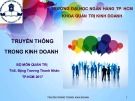
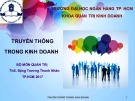
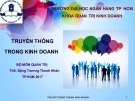
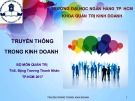

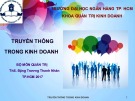


![Đề thi kết thúc học phần môn Truyền thông trong kinh doanh [năm học mới nhất]](https://cdn.tailieu.vn/images/document/thumbnail/2025/20251015/dilysstran/135x160/93281760499390.jpg)


![Bài tập nhóm truyền thông marketing tích hợp [mới nhất]](https://cdn.tailieu.vn/images/document/thumbnail/2025/20250904/hakanami1502@gmail.com/135x160/90671756969236.jpg)





![Định vị doanh nghiệp: Bài thuyết trình [Mới nhất]](https://cdn.tailieu.vn/images/document/thumbnail/2025/20250813/vuthuhuyen1407/135x160/6261755072381.jpg)



